ENGR20001: Reflective Report on Teamwork and Collaboration
VerifiedAdded on 2022/11/14
|6
|1491
|69
Report
AI Summary
This report reflects on a student's experience leading a team of junior engineering students during a summer course at the University of South Australia. The student, a senior in the Civil Engineering stream, was tasked with mentoring juniors, fostering collaboration, and facilitating knowledge sharing. The report details the course's objectives, the selection process for mentors, and the composition of the teams. It highlights the importance of teamwork, leadership qualities such as honesty, communication, and decision-making, and the challenges faced, including personality clashes and conflict resolution. The report discusses the advantages of teamwork, including knowledge sharing and the development of essential skills. Furthermore, it explores the critical aspects of effective engineering practice, such as proactiveness, practical application of knowledge, and the ability to handle pressure. The report also addresses the need for adaptability, resourcefulness, and effective communication to become a successful engineer. The student provides self-reflection on areas for improvement, emphasizing the importance of lifelong learning and adaptation to be a more effective engineer in a global context. The paper concludes with a list of references that support the claims presented.
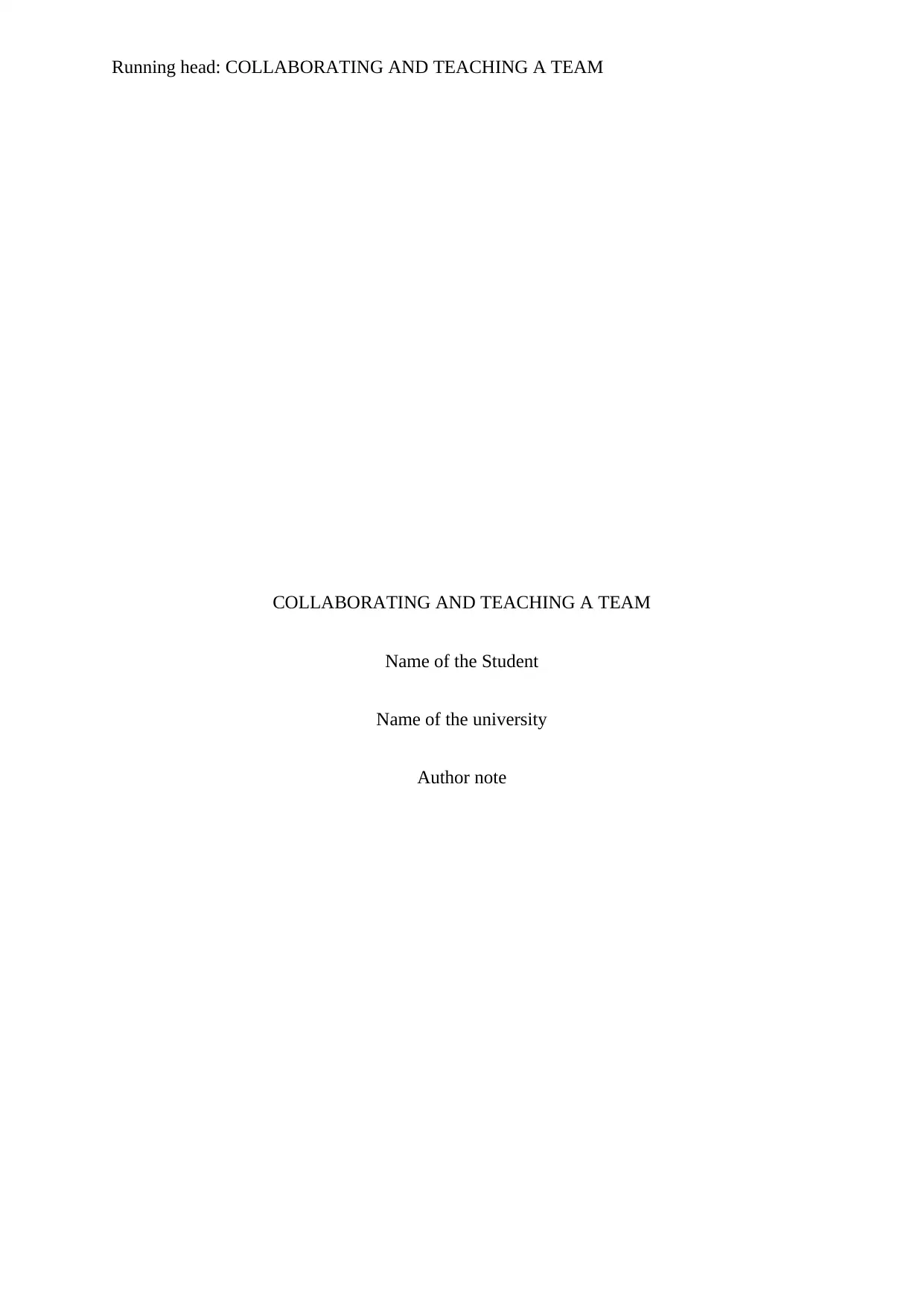
Running head: COLLABORATING AND TEACHING A TEAM
COLLABORATING AND TEACHING A TEAM
Name of the Student
Name of the university
Author note
COLLABORATING AND TEACHING A TEAM
Name of the Student
Name of the university
Author note
Paraphrase This Document
Need a fresh take? Get an instant paraphrase of this document with our AI Paraphraser
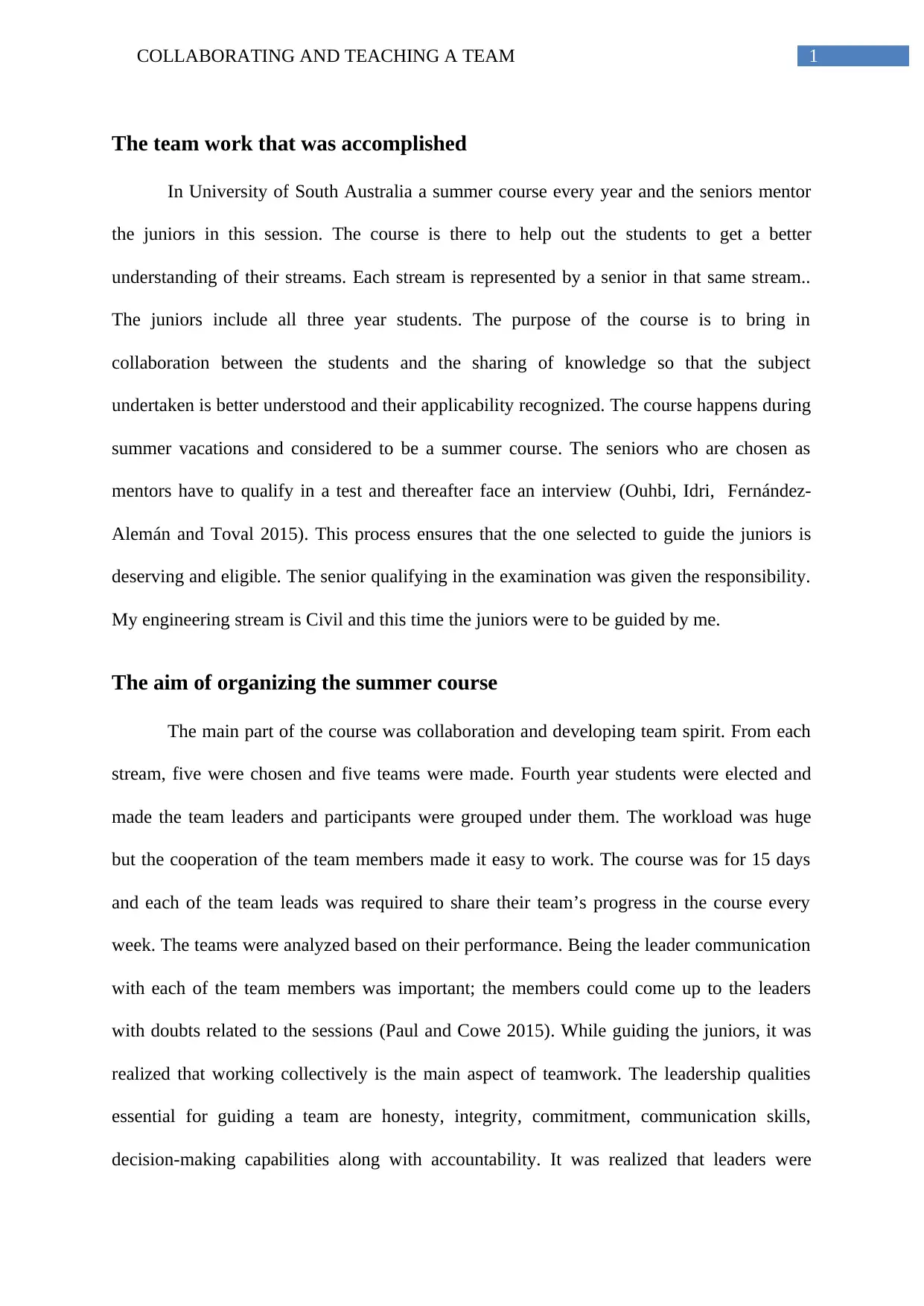
1COLLABORATING AND TEACHING A TEAM
The team work that was accomplished
In University of South Australia a summer course every year and the seniors mentor
the juniors in this session. The course is there to help out the students to get a better
understanding of their streams. Each stream is represented by a senior in that same stream..
The juniors include all three year students. The purpose of the course is to bring in
collaboration between the students and the sharing of knowledge so that the subject
undertaken is better understood and their applicability recognized. The course happens during
summer vacations and considered to be a summer course. The seniors who are chosen as
mentors have to qualify in a test and thereafter face an interview (Ouhbi, Idri, Fernández-
Alemán and Toval 2015). This process ensures that the one selected to guide the juniors is
deserving and eligible. The senior qualifying in the examination was given the responsibility.
My engineering stream is Civil and this time the juniors were to be guided by me.
The aim of organizing the summer course
The main part of the course was collaboration and developing team spirit. From each
stream, five were chosen and five teams were made. Fourth year students were elected and
made the team leaders and participants were grouped under them. The workload was huge
but the cooperation of the team members made it easy to work. The course was for 15 days
and each of the team leads was required to share their team’s progress in the course every
week. The teams were analyzed based on their performance. Being the leader communication
with each of the team members was important; the members could come up to the leaders
with doubts related to the sessions (Paul and Cowe 2015). While guiding the juniors, it was
realized that working collectively is the main aspect of teamwork. The leadership qualities
essential for guiding a team are honesty, integrity, commitment, communication skills,
decision-making capabilities along with accountability. It was realized that leaders were
The team work that was accomplished
In University of South Australia a summer course every year and the seniors mentor
the juniors in this session. The course is there to help out the students to get a better
understanding of their streams. Each stream is represented by a senior in that same stream..
The juniors include all three year students. The purpose of the course is to bring in
collaboration between the students and the sharing of knowledge so that the subject
undertaken is better understood and their applicability recognized. The course happens during
summer vacations and considered to be a summer course. The seniors who are chosen as
mentors have to qualify in a test and thereafter face an interview (Ouhbi, Idri, Fernández-
Alemán and Toval 2015). This process ensures that the one selected to guide the juniors is
deserving and eligible. The senior qualifying in the examination was given the responsibility.
My engineering stream is Civil and this time the juniors were to be guided by me.
The aim of organizing the summer course
The main part of the course was collaboration and developing team spirit. From each
stream, five were chosen and five teams were made. Fourth year students were elected and
made the team leaders and participants were grouped under them. The workload was huge
but the cooperation of the team members made it easy to work. The course was for 15 days
and each of the team leads was required to share their team’s progress in the course every
week. The teams were analyzed based on their performance. Being the leader communication
with each of the team members was important; the members could come up to the leaders
with doubts related to the sessions (Paul and Cowe 2015). While guiding the juniors, it was
realized that working collectively is the main aspect of teamwork. The leadership qualities
essential for guiding a team are honesty, integrity, commitment, communication skills,
decision-making capabilities along with accountability. It was realized that leaders were
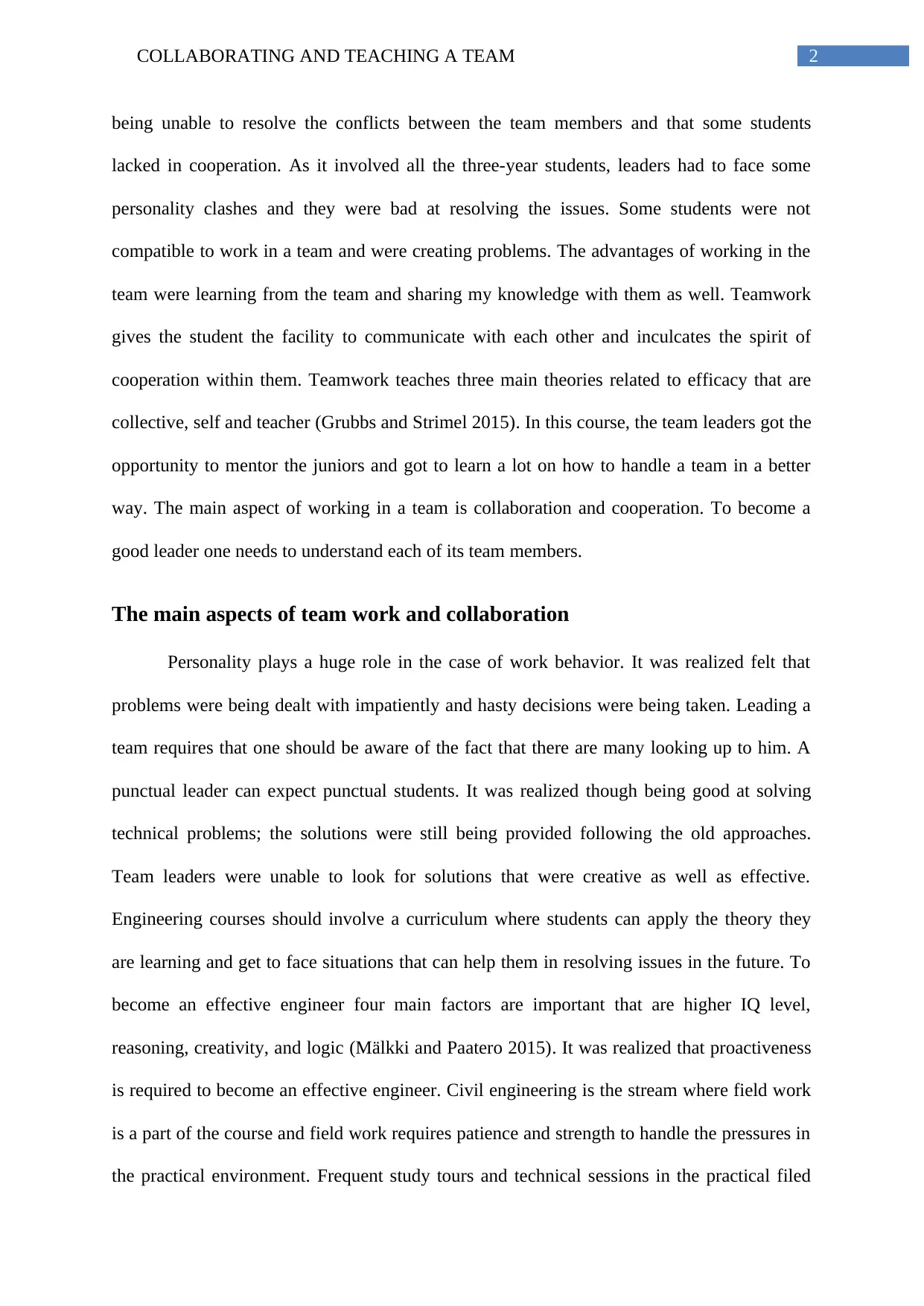
2COLLABORATING AND TEACHING A TEAM
being unable to resolve the conflicts between the team members and that some students
lacked in cooperation. As it involved all the three-year students, leaders had to face some
personality clashes and they were bad at resolving the issues. Some students were not
compatible to work in a team and were creating problems. The advantages of working in the
team were learning from the team and sharing my knowledge with them as well. Teamwork
gives the student the facility to communicate with each other and inculcates the spirit of
cooperation within them. Teamwork teaches three main theories related to efficacy that are
collective, self and teacher (Grubbs and Strimel 2015). In this course, the team leaders got the
opportunity to mentor the juniors and got to learn a lot on how to handle a team in a better
way. The main aspect of working in a team is collaboration and cooperation. To become a
good leader one needs to understand each of its team members.
The main aspects of team work and collaboration
Personality plays a huge role in the case of work behavior. It was realized felt that
problems were being dealt with impatiently and hasty decisions were being taken. Leading a
team requires that one should be aware of the fact that there are many looking up to him. A
punctual leader can expect punctual students. It was realized though being good at solving
technical problems; the solutions were still being provided following the old approaches.
Team leaders were unable to look for solutions that were creative as well as effective.
Engineering courses should involve a curriculum where students can apply the theory they
are learning and get to face situations that can help them in resolving issues in the future. To
become an effective engineer four main factors are important that are higher IQ level,
reasoning, creativity, and logic (Mälkki and Paatero 2015). It was realized that proactiveness
is required to become an effective engineer. Civil engineering is the stream where field work
is a part of the course and field work requires patience and strength to handle the pressures in
the practical environment. Frequent study tours and technical sessions in the practical filed
being unable to resolve the conflicts between the team members and that some students
lacked in cooperation. As it involved all the three-year students, leaders had to face some
personality clashes and they were bad at resolving the issues. Some students were not
compatible to work in a team and were creating problems. The advantages of working in the
team were learning from the team and sharing my knowledge with them as well. Teamwork
gives the student the facility to communicate with each other and inculcates the spirit of
cooperation within them. Teamwork teaches three main theories related to efficacy that are
collective, self and teacher (Grubbs and Strimel 2015). In this course, the team leaders got the
opportunity to mentor the juniors and got to learn a lot on how to handle a team in a better
way. The main aspect of working in a team is collaboration and cooperation. To become a
good leader one needs to understand each of its team members.
The main aspects of team work and collaboration
Personality plays a huge role in the case of work behavior. It was realized felt that
problems were being dealt with impatiently and hasty decisions were being taken. Leading a
team requires that one should be aware of the fact that there are many looking up to him. A
punctual leader can expect punctual students. It was realized though being good at solving
technical problems; the solutions were still being provided following the old approaches.
Team leaders were unable to look for solutions that were creative as well as effective.
Engineering courses should involve a curriculum where students can apply the theory they
are learning and get to face situations that can help them in resolving issues in the future. To
become an effective engineer four main factors are important that are higher IQ level,
reasoning, creativity, and logic (Mälkki and Paatero 2015). It was realized that proactiveness
is required to become an effective engineer. Civil engineering is the stream where field work
is a part of the course and field work requires patience and strength to handle the pressures in
the practical environment. Frequent study tours and technical sessions in the practical filed
⊘ This is a preview!⊘
Do you want full access?
Subscribe today to unlock all pages.

Trusted by 1+ million students worldwide
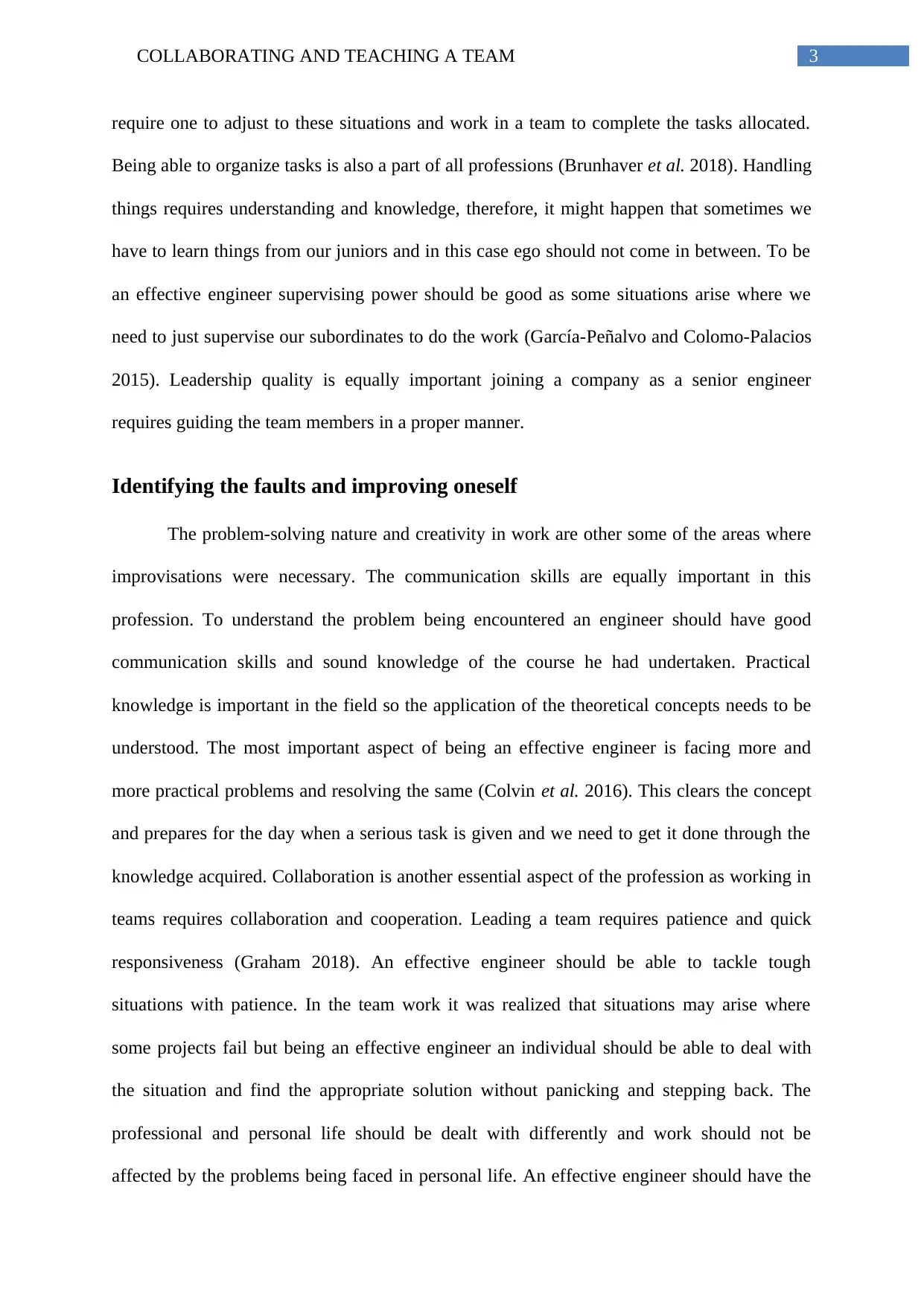
3COLLABORATING AND TEACHING A TEAM
require one to adjust to these situations and work in a team to complete the tasks allocated.
Being able to organize tasks is also a part of all professions (Brunhaver et al. 2018). Handling
things requires understanding and knowledge, therefore, it might happen that sometimes we
have to learn things from our juniors and in this case ego should not come in between. To be
an effective engineer supervising power should be good as some situations arise where we
need to just supervise our subordinates to do the work (García-Peñalvo and Colomo-Palacios
2015). Leadership quality is equally important joining a company as a senior engineer
requires guiding the team members in a proper manner.
Identifying the faults and improving oneself
The problem-solving nature and creativity in work are other some of the areas where
improvisations were necessary. The communication skills are equally important in this
profession. To understand the problem being encountered an engineer should have good
communication skills and sound knowledge of the course he had undertaken. Practical
knowledge is important in the field so the application of the theoretical concepts needs to be
understood. The most important aspect of being an effective engineer is facing more and
more practical problems and resolving the same (Colvin et al. 2016). This clears the concept
and prepares for the day when a serious task is given and we need to get it done through the
knowledge acquired. Collaboration is another essential aspect of the profession as working in
teams requires collaboration and cooperation. Leading a team requires patience and quick
responsiveness (Graham 2018). An effective engineer should be able to tackle tough
situations with patience. In the team work it was realized that situations may arise where
some projects fail but being an effective engineer an individual should be able to deal with
the situation and find the appropriate solution without panicking and stepping back. The
professional and personal life should be dealt with differently and work should not be
affected by the problems being faced in personal life. An effective engineer should have the
require one to adjust to these situations and work in a team to complete the tasks allocated.
Being able to organize tasks is also a part of all professions (Brunhaver et al. 2018). Handling
things requires understanding and knowledge, therefore, it might happen that sometimes we
have to learn things from our juniors and in this case ego should not come in between. To be
an effective engineer supervising power should be good as some situations arise where we
need to just supervise our subordinates to do the work (García-Peñalvo and Colomo-Palacios
2015). Leadership quality is equally important joining a company as a senior engineer
requires guiding the team members in a proper manner.
Identifying the faults and improving oneself
The problem-solving nature and creativity in work are other some of the areas where
improvisations were necessary. The communication skills are equally important in this
profession. To understand the problem being encountered an engineer should have good
communication skills and sound knowledge of the course he had undertaken. Practical
knowledge is important in the field so the application of the theoretical concepts needs to be
understood. The most important aspect of being an effective engineer is facing more and
more practical problems and resolving the same (Colvin et al. 2016). This clears the concept
and prepares for the day when a serious task is given and we need to get it done through the
knowledge acquired. Collaboration is another essential aspect of the profession as working in
teams requires collaboration and cooperation. Leading a team requires patience and quick
responsiveness (Graham 2018). An effective engineer should be able to tackle tough
situations with patience. In the team work it was realized that situations may arise where
some projects fail but being an effective engineer an individual should be able to deal with
the situation and find the appropriate solution without panicking and stepping back. The
professional and personal life should be dealt with differently and work should not be
affected by the problems being faced in personal life. An effective engineer should have the
Paraphrase This Document
Need a fresh take? Get an instant paraphrase of this document with our AI Paraphraser
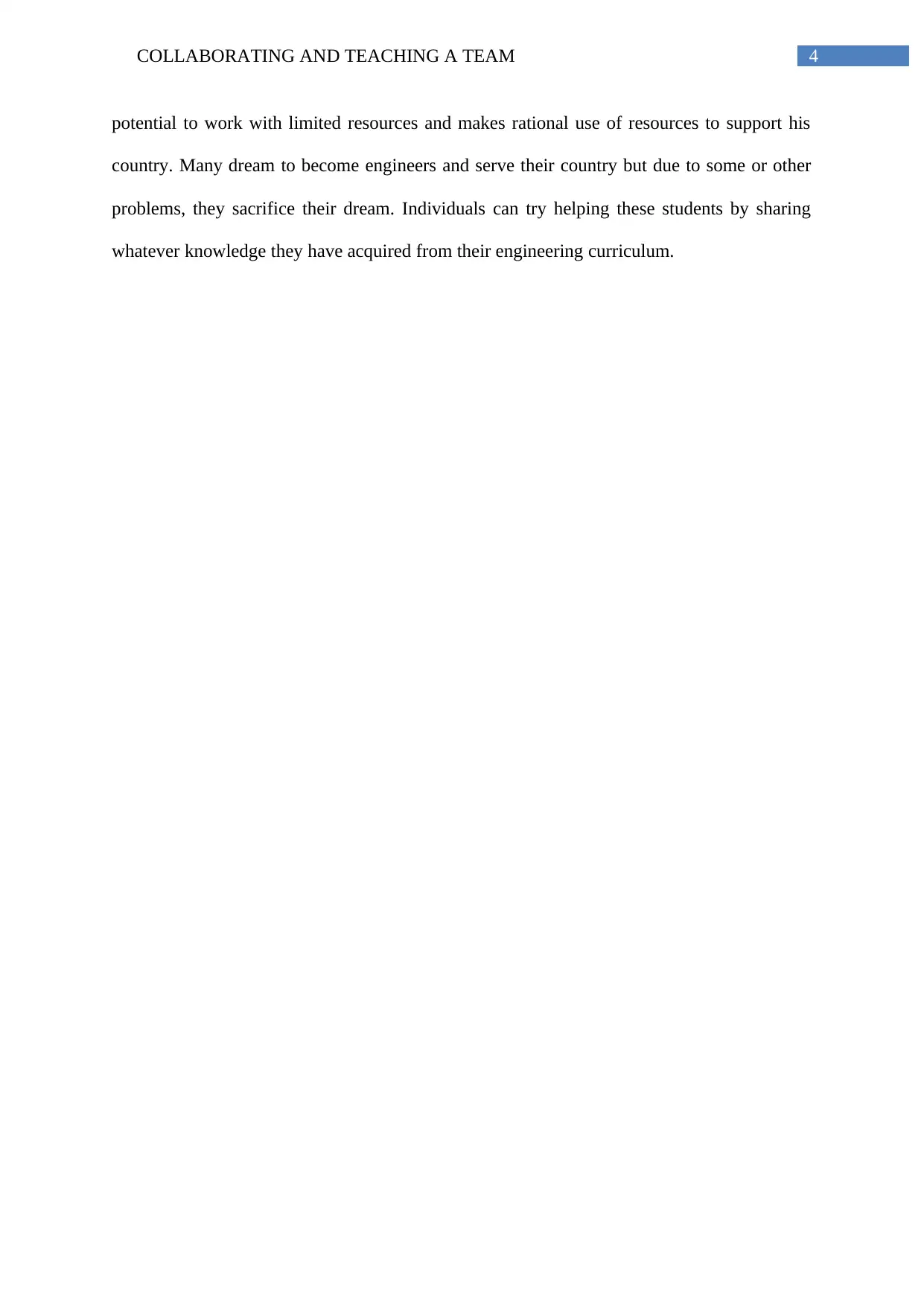
4COLLABORATING AND TEACHING A TEAM
potential to work with limited resources and makes rational use of resources to support his
country. Many dream to become engineers and serve their country but due to some or other
problems, they sacrifice their dream. Individuals can try helping these students by sharing
whatever knowledge they have acquired from their engineering curriculum.
potential to work with limited resources and makes rational use of resources to support his
country. Many dream to become engineers and serve their country but due to some or other
problems, they sacrifice their dream. Individuals can try helping these students by sharing
whatever knowledge they have acquired from their engineering curriculum.
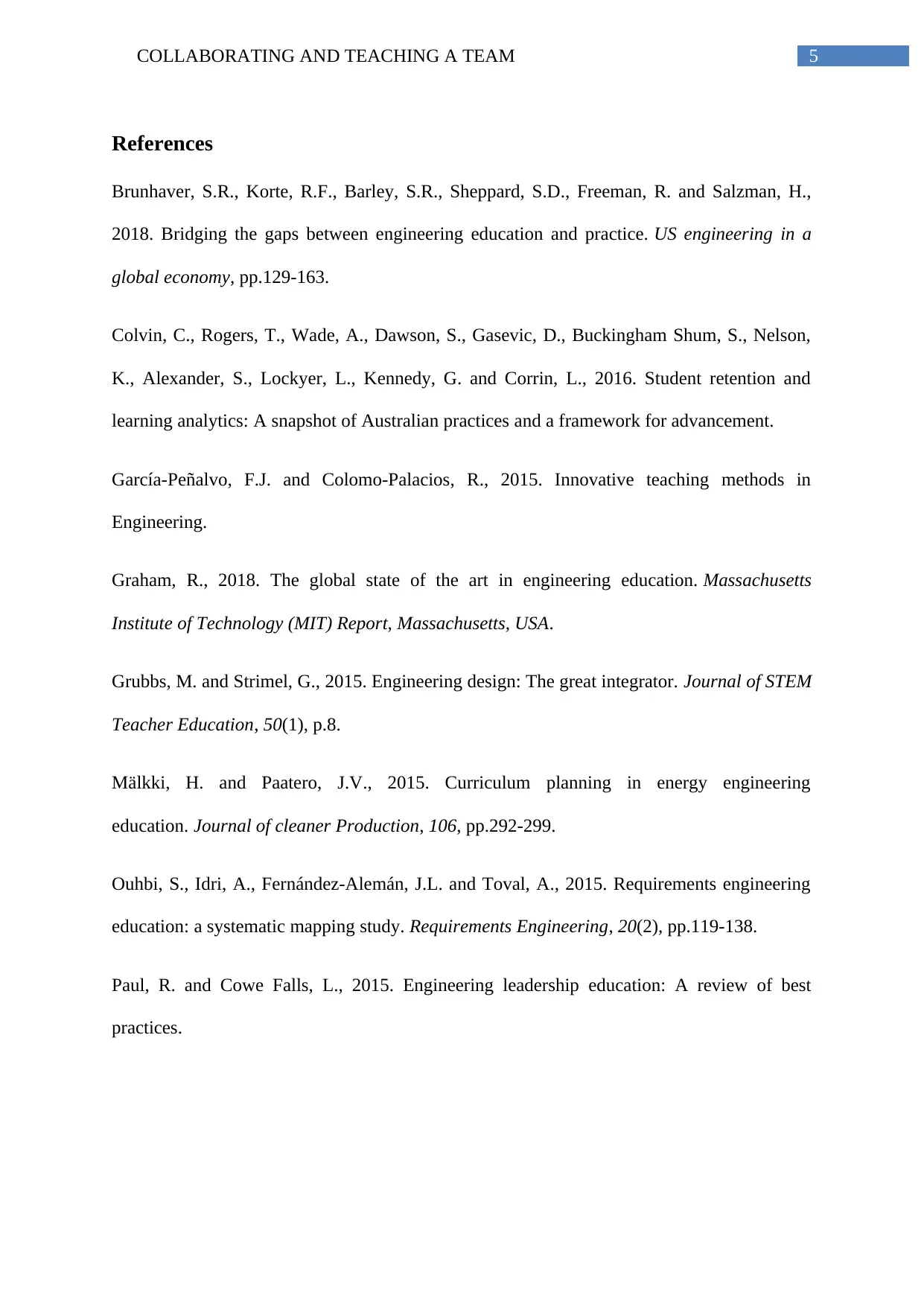
5COLLABORATING AND TEACHING A TEAM
References
Brunhaver, S.R., Korte, R.F., Barley, S.R., Sheppard, S.D., Freeman, R. and Salzman, H.,
2018. Bridging the gaps between engineering education and practice. US engineering in a
global economy, pp.129-163.
Colvin, C., Rogers, T., Wade, A., Dawson, S., Gasevic, D., Buckingham Shum, S., Nelson,
K., Alexander, S., Lockyer, L., Kennedy, G. and Corrin, L., 2016. Student retention and
learning analytics: A snapshot of Australian practices and a framework for advancement.
García-Peñalvo, F.J. and Colomo-Palacios, R., 2015. Innovative teaching methods in
Engineering.
Graham, R., 2018. The global state of the art in engineering education. Massachusetts
Institute of Technology (MIT) Report, Massachusetts, USA.
Grubbs, M. and Strimel, G., 2015. Engineering design: The great integrator. Journal of STEM
Teacher Education, 50(1), p.8.
Mälkki, H. and Paatero, J.V., 2015. Curriculum planning in energy engineering
education. Journal of cleaner Production, 106, pp.292-299.
Ouhbi, S., Idri, A., Fernández-Alemán, J.L. and Toval, A., 2015. Requirements engineering
education: a systematic mapping study. Requirements Engineering, 20(2), pp.119-138.
Paul, R. and Cowe Falls, L., 2015. Engineering leadership education: A review of best
practices.
References
Brunhaver, S.R., Korte, R.F., Barley, S.R., Sheppard, S.D., Freeman, R. and Salzman, H.,
2018. Bridging the gaps between engineering education and practice. US engineering in a
global economy, pp.129-163.
Colvin, C., Rogers, T., Wade, A., Dawson, S., Gasevic, D., Buckingham Shum, S., Nelson,
K., Alexander, S., Lockyer, L., Kennedy, G. and Corrin, L., 2016. Student retention and
learning analytics: A snapshot of Australian practices and a framework for advancement.
García-Peñalvo, F.J. and Colomo-Palacios, R., 2015. Innovative teaching methods in
Engineering.
Graham, R., 2018. The global state of the art in engineering education. Massachusetts
Institute of Technology (MIT) Report, Massachusetts, USA.
Grubbs, M. and Strimel, G., 2015. Engineering design: The great integrator. Journal of STEM
Teacher Education, 50(1), p.8.
Mälkki, H. and Paatero, J.V., 2015. Curriculum planning in energy engineering
education. Journal of cleaner Production, 106, pp.292-299.
Ouhbi, S., Idri, A., Fernández-Alemán, J.L. and Toval, A., 2015. Requirements engineering
education: a systematic mapping study. Requirements Engineering, 20(2), pp.119-138.
Paul, R. and Cowe Falls, L., 2015. Engineering leadership education: A review of best
practices.
⊘ This is a preview!⊘
Do you want full access?
Subscribe today to unlock all pages.

Trusted by 1+ million students worldwide
1 out of 6
Related Documents
Your All-in-One AI-Powered Toolkit for Academic Success.
+13062052269
info@desklib.com
Available 24*7 on WhatsApp / Email
![[object Object]](/_next/static/media/star-bottom.7253800d.svg)
Unlock your academic potential
Copyright © 2020–2025 A2Z Services. All Rights Reserved. Developed and managed by ZUCOL.





